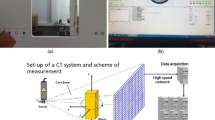Abstract
This paper focuses on a new method to visualize weathering effects due to the physical changes of stone artifacts. Major parameters concerned with both the breakdown process and changes of properties of the particles that comprise the stone artifact are considered. We pay attention to the fact that the common and main cause of weathering is granular disintegration and that such disintegration depends on the porosity, that is to say the percentage of voids. We define an estimation function in time for transient behaviors of the physical properties of stone, the material for sculpture. In order to visualize the erosion of a stone sample, voxel-based representation has a decided advantage. Accordingly, a representation of a sculpture with surface modeling using polygons and mesh is converted to a voxel-based representation. The voxels are treated as particles of a sculpture; we observe the transient changes of the physical properties for each voxel. To ensure natural conditions, initial states of the particles are defined using a probability distribution function. It was possible to realize a natural expression of the aging effects of stone by applying weighting factors depending on how voxels are exposed to the surrounding environment. In addition, for computational efficiency, instead of including all voxels when calculating property changes, only the surface voxels of the sculpture are calculated for transient changes.
















Similar content being viewed by others
References
Chen TC, Yeung MR, Mori N (2004) Effect of water saturation on deterioration of welded tuff due to freeze–thaw action. Cold Reg Sci Technol 38(2–3):127–136
Christou G (2013) A comparison between experienced and inexperienced video game players’ perceptions. Hum Centric Comput Inf Sci 2013:3–15. doi:10.1186/2192-1962-3-15
Divya Udayan J, Kim HS, Lee J, Kim J-I (2013) Fractal based method on hardware acceleration for natural environments. J Converg 4(3):6–12
Hall K (1999) The role of thermal stress fatigue in the breakdown of rock in cold regions. Geomorphology 31(1–4):47–63
Ho Y-S (2013) Challenging technical issues of 3D video processing. J Converg 4(1):1–6
Jung M-H, Lee J-H, Shon B-H (2009) Changes in the physical properties of granite by weathering. Korea Acad Ind Coop Soc 10(8):2026–2031
Mutlutürk M, Altindag R, Türk G (2004) A decay function model for the integrity loss of rock when subjected to recurrent cycles of freezing–thawing and heating-cooling. Int J Rock Mech Min Sci 41(2):237–244
Nicholson DT, Nicholson FH (2000) Physical deterioration of sedimentary rocks subjected to experimental freeze–thaw weathering. Earth Surf Process Landf 25(12):1295–1307
Ryu S, Song J-J (2012) Weathering of rock specimens exposed to recurrent freezing and thawing cycles. Korean Soc Rock Mech 22(4):276–283
Tan X, Chen W, Yang J, Cao J (2011) Laboratory investigations on the mechanical properties degradation of granite under freeze-thaw cycles. Cold Reg Sci Technol 68(3):130–138
Um J-G (2012) A study of weathering characteristics of cretaceous granite in Kimhae area due to artificial weathering processes. Korean Soc Rock Mech 22(1):32–42
Woo I, Um J-G, Park H-J (2009) Variation of geomechanical characteristics of granite and orthogneiss in Wonju area due to accelerated artificial chemical weathering tests. Korean Soc Rock Mech 19(3):213–225
Yang J-H (2011) The effect of a freeze-thaw cycle on rock weathering. Korean Geomorphol Assoc 18(3):21–36
Yavuz H, Altindag R, Sarac S, Ugur I, Sengun N (2006) Estimating the index properties of deteriorated carbonate rocks due to freeze–thaw and thermal shock weathering. Int J Rock Mech Min Sci 43(5):767–775
Acknowledgments
This research is supported by National Research Foundation of Korea (NRF) funded by the Ministry of Education, Science and Technology through the Basic Science Research Program (201204400001).
Author information
Authors and Affiliations
Corresponding author
Rights and permissions
About this article
Cite this article
Lee, S., Kim, JW. & Ahn, E. A visual simulation method for weathering progress of stone artifacts. Multimed Tools Appl 75, 15247–15259 (2016). https://doi.org/10.1007/s11042-015-2507-7
Received:
Revised:
Accepted:
Published:
Issue Date:
DOI: https://doi.org/10.1007/s11042-015-2507-7




